Economic Evaluation of Anxiety Intervention in Secondary Schools
VerifiedAdded on 2022/12/30
|12
|3158
|25
Essay
AI Summary
This essay presents an economic evaluation of an "Anxiety Free" intervention designed to prevent anxiety among secondary school students. The study utilizes cost-benefit analysis to assess the program's value, considering healthcare costs, non-healthcare costs, and patient/family costs. The intervention comprises two components: identifying at-risk students and providing online modules. The essay explores the intervention's design, relevant population, health outcomes, and the study's time horizon, which is set at eight weeks. The study perspective includes costs and benefits for students, families, and healthcare providers. The resource collection focuses on professional resource costs, non-health care costs, and patient or family costs. The essay also addresses data sources, including patient-supplied and administrative data, and how health outcomes will be measured. The evaluation aims to determine the cost-effectiveness of the intervention and its impact on anxiety prevention, diagnosis, referrals, and prescription rates.
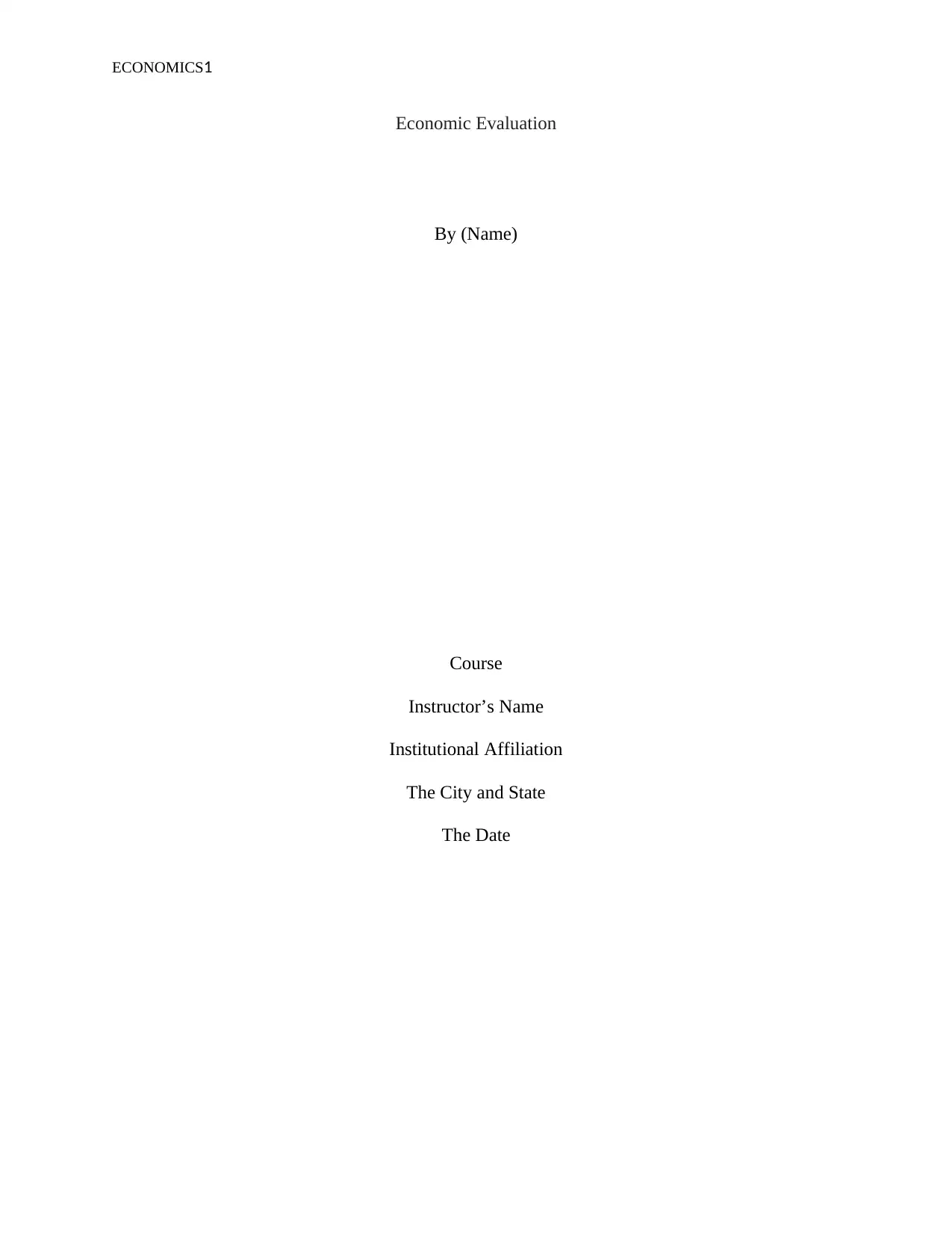
ECONOMICS1
Economic Evaluation
By (Name)
Course
Instructor’s Name
Institutional Affiliation
The City and State
The Date
Economic Evaluation
By (Name)
Course
Instructor’s Name
Institutional Affiliation
The City and State
The Date
Paraphrase This Document
Need a fresh take? Get an instant paraphrase of this document with our AI Paraphraser
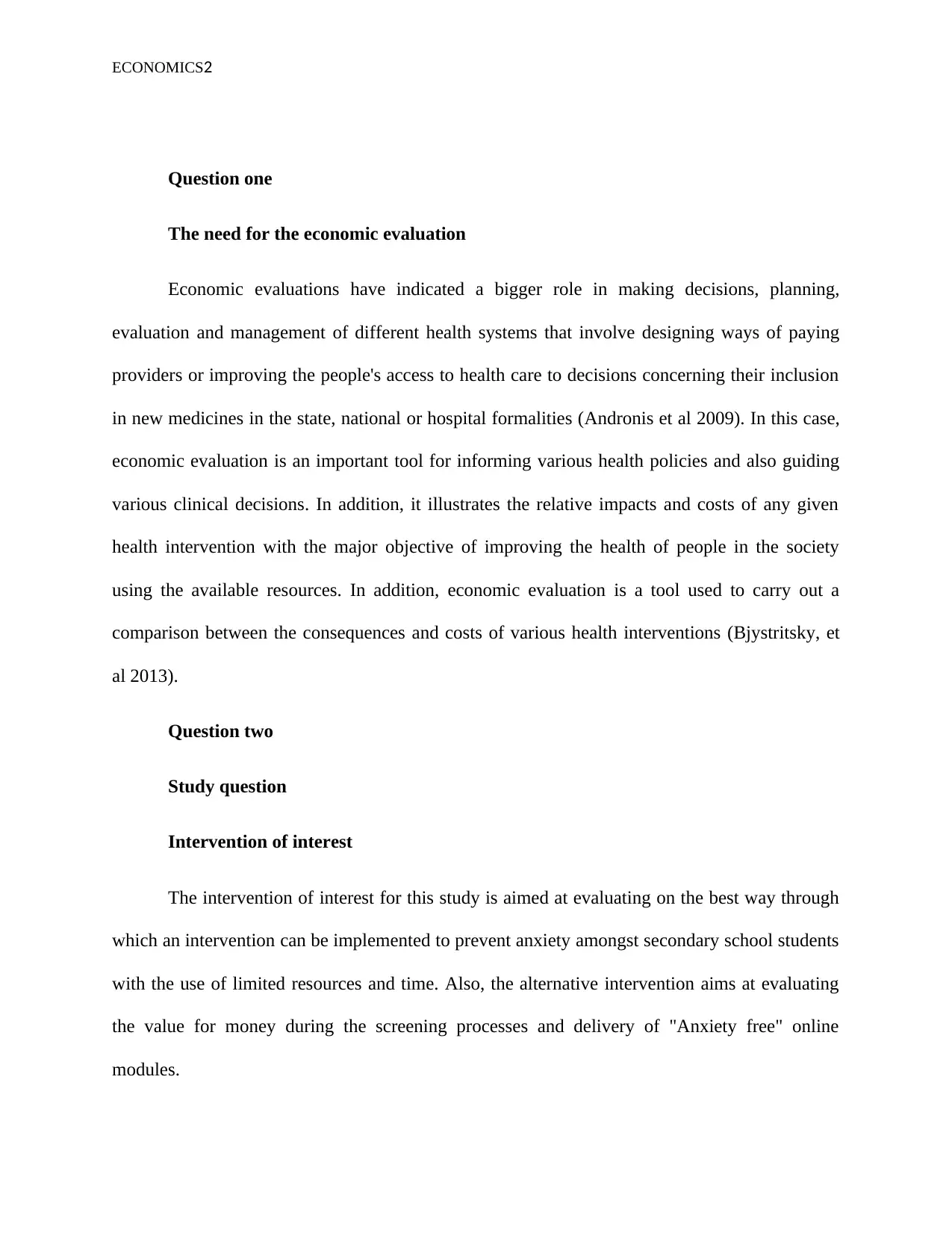
ECONOMICS2
Question one
The need for the economic evaluation
Economic evaluations have indicated a bigger role in making decisions, planning,
evaluation and management of different health systems that involve designing ways of paying
providers or improving the people's access to health care to decisions concerning their inclusion
in new medicines in the state, national or hospital formalities (Andronis et al 2009). In this case,
economic evaluation is an important tool for informing various health policies and also guiding
various clinical decisions. In addition, it illustrates the relative impacts and costs of any given
health intervention with the major objective of improving the health of people in the society
using the available resources. In addition, economic evaluation is a tool used to carry out a
comparison between the consequences and costs of various health interventions (Bjystritsky, et
al 2013).
Question two
Study question
Intervention of interest
The intervention of interest for this study is aimed at evaluating on the best way through
which an intervention can be implemented to prevent anxiety amongst secondary school students
with the use of limited resources and time. Also, the alternative intervention aims at evaluating
the value for money during the screening processes and delivery of "Anxiety free" online
modules.
Question one
The need for the economic evaluation
Economic evaluations have indicated a bigger role in making decisions, planning,
evaluation and management of different health systems that involve designing ways of paying
providers or improving the people's access to health care to decisions concerning their inclusion
in new medicines in the state, national or hospital formalities (Andronis et al 2009). In this case,
economic evaluation is an important tool for informing various health policies and also guiding
various clinical decisions. In addition, it illustrates the relative impacts and costs of any given
health intervention with the major objective of improving the health of people in the society
using the available resources. In addition, economic evaluation is a tool used to carry out a
comparison between the consequences and costs of various health interventions (Bjystritsky, et
al 2013).
Question two
Study question
Intervention of interest
The intervention of interest for this study is aimed at evaluating on the best way through
which an intervention can be implemented to prevent anxiety amongst secondary school students
with the use of limited resources and time. Also, the alternative intervention aims at evaluating
the value for money during the screening processes and delivery of "Anxiety free" online
modules.
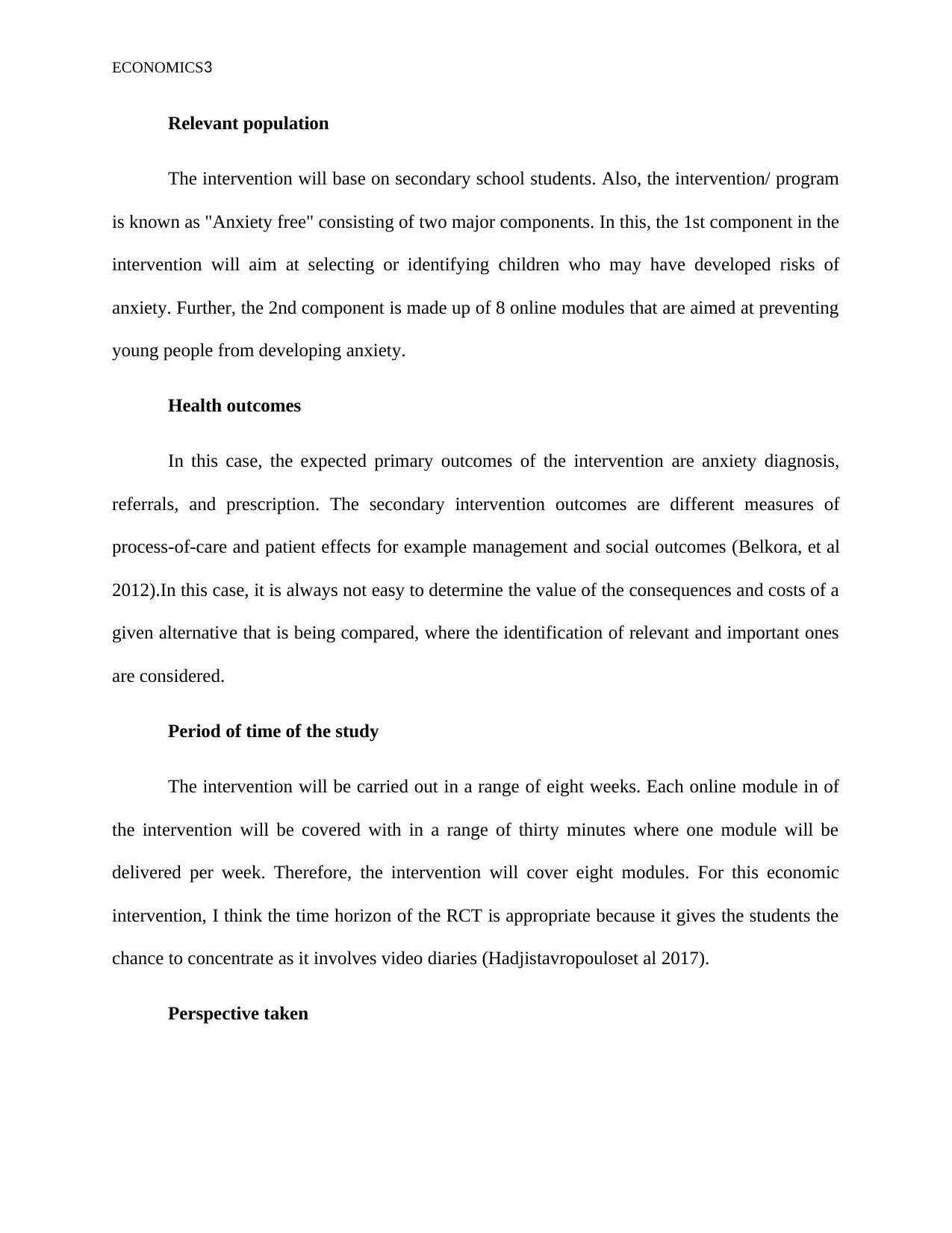
ECONOMICS3
Relevant population
The intervention will base on secondary school students. Also, the intervention/ program
is known as "Anxiety free" consisting of two major components. In this, the 1st component in the
intervention will aim at selecting or identifying children who may have developed risks of
anxiety. Further, the 2nd component is made up of 8 online modules that are aimed at preventing
young people from developing anxiety.
Health outcomes
In this case, the expected primary outcomes of the intervention are anxiety diagnosis,
referrals, and prescription. The secondary intervention outcomes are different measures of
process-of-care and patient effects for example management and social outcomes (Belkora, et al
2012).In this case, it is always not easy to determine the value of the consequences and costs of a
given alternative that is being compared, where the identification of relevant and important ones
are considered.
Period of time of the study
The intervention will be carried out in a range of eight weeks. Each online module in of
the intervention will be covered with in a range of thirty minutes where one module will be
delivered per week. Therefore, the intervention will cover eight modules. For this economic
intervention, I think the time horizon of the RCT is appropriate because it gives the students the
chance to concentrate as it involves video diaries (Hadjistavropouloset al 2017).
Perspective taken
Relevant population
The intervention will base on secondary school students. Also, the intervention/ program
is known as "Anxiety free" consisting of two major components. In this, the 1st component in the
intervention will aim at selecting or identifying children who may have developed risks of
anxiety. Further, the 2nd component is made up of 8 online modules that are aimed at preventing
young people from developing anxiety.
Health outcomes
In this case, the expected primary outcomes of the intervention are anxiety diagnosis,
referrals, and prescription. The secondary intervention outcomes are different measures of
process-of-care and patient effects for example management and social outcomes (Belkora, et al
2012).In this case, it is always not easy to determine the value of the consequences and costs of a
given alternative that is being compared, where the identification of relevant and important ones
are considered.
Period of time of the study
The intervention will be carried out in a range of eight weeks. Each online module in of
the intervention will be covered with in a range of thirty minutes where one module will be
delivered per week. Therefore, the intervention will cover eight modules. For this economic
intervention, I think the time horizon of the RCT is appropriate because it gives the students the
chance to concentrate as it involves video diaries (Hadjistavropouloset al 2017).
Perspective taken
⊘ This is a preview!⊘
Do you want full access?
Subscribe today to unlock all pages.

Trusted by 1+ million students worldwide
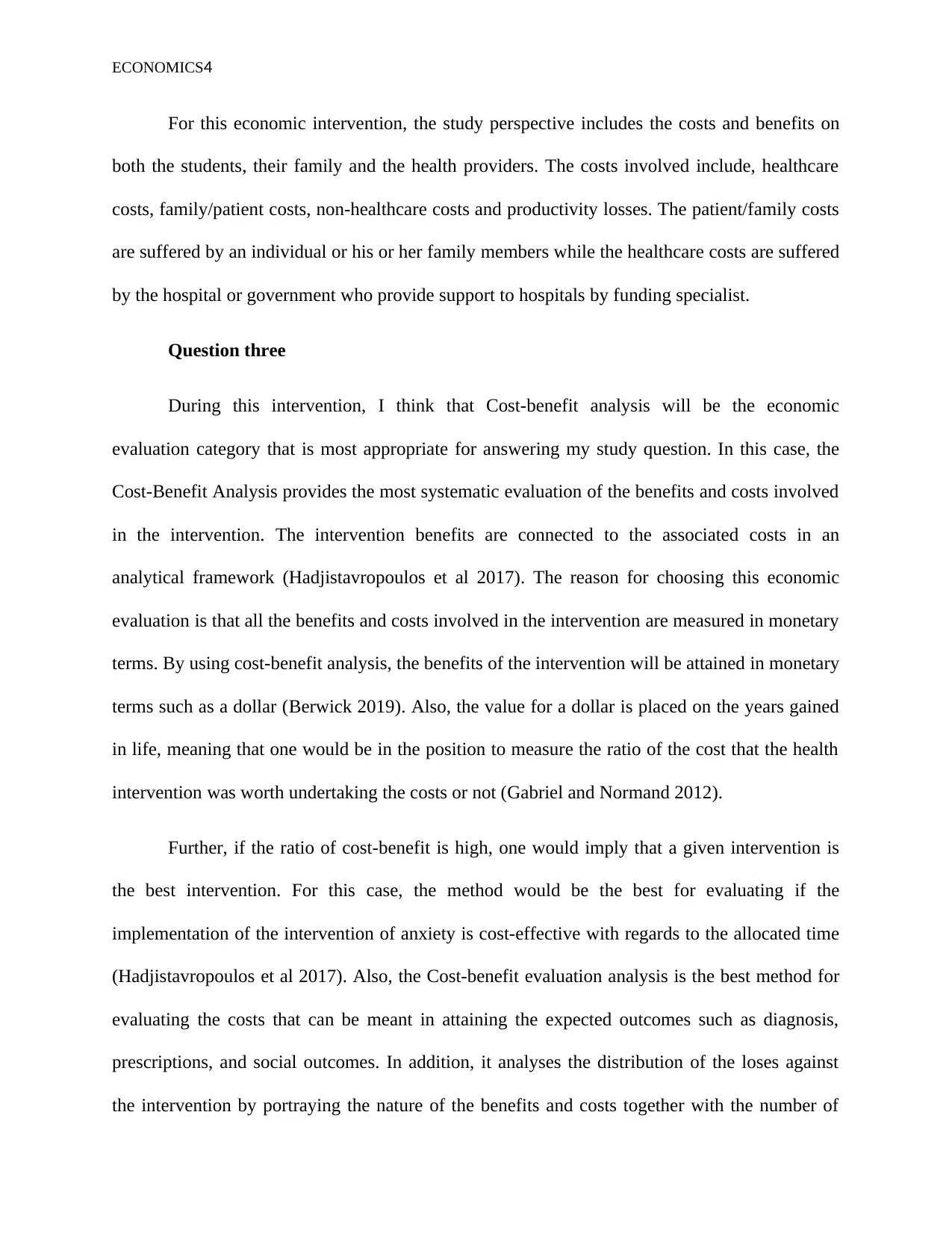
ECONOMICS4
For this economic intervention, the study perspective includes the costs and benefits on
both the students, their family and the health providers. The costs involved include, healthcare
costs, family/patient costs, non-healthcare costs and productivity losses. The patient/family costs
are suffered by an individual or his or her family members while the healthcare costs are suffered
by the hospital or government who provide support to hospitals by funding specialist.
Question three
During this intervention, I think that Cost-benefit analysis will be the economic
evaluation category that is most appropriate for answering my study question. In this case, the
Cost-Benefit Analysis provides the most systematic evaluation of the benefits and costs involved
in the intervention. The intervention benefits are connected to the associated costs in an
analytical framework (Hadjistavropoulos et al 2017). The reason for choosing this economic
evaluation is that all the benefits and costs involved in the intervention are measured in monetary
terms. By using cost-benefit analysis, the benefits of the intervention will be attained in monetary
terms such as a dollar (Berwick 2019). Also, the value for a dollar is placed on the years gained
in life, meaning that one would be in the position to measure the ratio of the cost that the health
intervention was worth undertaking the costs or not (Gabriel and Normand 2012).
Further, if the ratio of cost-benefit is high, one would imply that a given intervention is
the best intervention. For this case, the method would be the best for evaluating if the
implementation of the intervention of anxiety is cost-effective with regards to the allocated time
(Hadjistavropoulos et al 2017). Also, the Cost-benefit evaluation analysis is the best method for
evaluating the costs that can be meant in attaining the expected outcomes such as diagnosis,
prescriptions, and social outcomes. In addition, it analyses the distribution of the loses against
the intervention by portraying the nature of the benefits and costs together with the number of
For this economic intervention, the study perspective includes the costs and benefits on
both the students, their family and the health providers. The costs involved include, healthcare
costs, family/patient costs, non-healthcare costs and productivity losses. The patient/family costs
are suffered by an individual or his or her family members while the healthcare costs are suffered
by the hospital or government who provide support to hospitals by funding specialist.
Question three
During this intervention, I think that Cost-benefit analysis will be the economic
evaluation category that is most appropriate for answering my study question. In this case, the
Cost-Benefit Analysis provides the most systematic evaluation of the benefits and costs involved
in the intervention. The intervention benefits are connected to the associated costs in an
analytical framework (Hadjistavropoulos et al 2017). The reason for choosing this economic
evaluation is that all the benefits and costs involved in the intervention are measured in monetary
terms. By using cost-benefit analysis, the benefits of the intervention will be attained in monetary
terms such as a dollar (Berwick 2019). Also, the value for a dollar is placed on the years gained
in life, meaning that one would be in the position to measure the ratio of the cost that the health
intervention was worth undertaking the costs or not (Gabriel and Normand 2012).
Further, if the ratio of cost-benefit is high, one would imply that a given intervention is
the best intervention. For this case, the method would be the best for evaluating if the
implementation of the intervention of anxiety is cost-effective with regards to the allocated time
(Hadjistavropoulos et al 2017). Also, the Cost-benefit evaluation analysis is the best method for
evaluating the costs that can be meant in attaining the expected outcomes such as diagnosis,
prescriptions, and social outcomes. In addition, it analyses the distribution of the loses against
the intervention by portraying the nature of the benefits and costs together with the number of
Paraphrase This Document
Need a fresh take? Get an instant paraphrase of this document with our AI Paraphraser
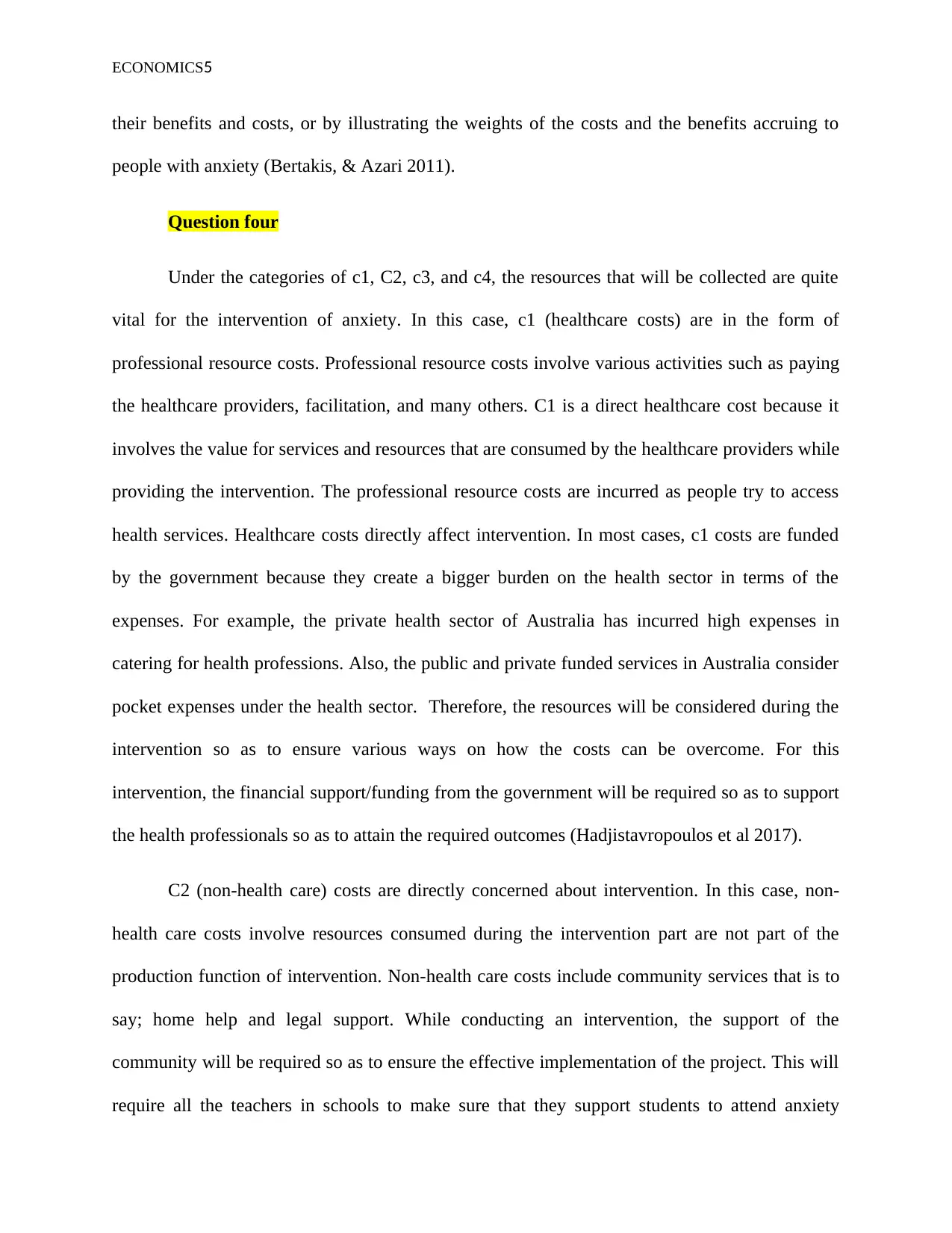
ECONOMICS5
their benefits and costs, or by illustrating the weights of the costs and the benefits accruing to
people with anxiety (Bertakis, & Azari 2011).
Question four
Under the categories of c1, C2, c3, and c4, the resources that will be collected are quite
vital for the intervention of anxiety. In this case, c1 (healthcare costs) are in the form of
professional resource costs. Professional resource costs involve various activities such as paying
the healthcare providers, facilitation, and many others. C1 is a direct healthcare cost because it
involves the value for services and resources that are consumed by the healthcare providers while
providing the intervention. The professional resource costs are incurred as people try to access
health services. Healthcare costs directly affect intervention. In most cases, c1 costs are funded
by the government because they create a bigger burden on the health sector in terms of the
expenses. For example, the private health sector of Australia has incurred high expenses in
catering for health professions. Also, the public and private funded services in Australia consider
pocket expenses under the health sector. Therefore, the resources will be considered during the
intervention so as to ensure various ways on how the costs can be overcome. For this
intervention, the financial support/funding from the government will be required so as to support
the health professionals so as to attain the required outcomes (Hadjistavropoulos et al 2017).
C2 (non-health care) costs are directly concerned about intervention. In this case, non-
health care costs involve resources consumed during the intervention part are not part of the
production function of intervention. Non-health care costs include community services that is to
say; home help and legal support. While conducting an intervention, the support of the
community will be required so as to ensure the effective implementation of the project. This will
require all the teachers in schools to make sure that they support students to attend anxiety
their benefits and costs, or by illustrating the weights of the costs and the benefits accruing to
people with anxiety (Bertakis, & Azari 2011).
Question four
Under the categories of c1, C2, c3, and c4, the resources that will be collected are quite
vital for the intervention of anxiety. In this case, c1 (healthcare costs) are in the form of
professional resource costs. Professional resource costs involve various activities such as paying
the healthcare providers, facilitation, and many others. C1 is a direct healthcare cost because it
involves the value for services and resources that are consumed by the healthcare providers while
providing the intervention. The professional resource costs are incurred as people try to access
health services. Healthcare costs directly affect intervention. In most cases, c1 costs are funded
by the government because they create a bigger burden on the health sector in terms of the
expenses. For example, the private health sector of Australia has incurred high expenses in
catering for health professions. Also, the public and private funded services in Australia consider
pocket expenses under the health sector. Therefore, the resources will be considered during the
intervention so as to ensure various ways on how the costs can be overcome. For this
intervention, the financial support/funding from the government will be required so as to support
the health professionals so as to attain the required outcomes (Hadjistavropoulos et al 2017).
C2 (non-health care) costs are directly concerned about intervention. In this case, non-
health care costs involve resources consumed during the intervention part are not part of the
production function of intervention. Non-health care costs include community services that is to
say; home help and legal support. While conducting an intervention, the support of the
community will be required so as to ensure the effective implementation of the project. This will
require all the teachers in schools to make sure that they support students to attend anxiety
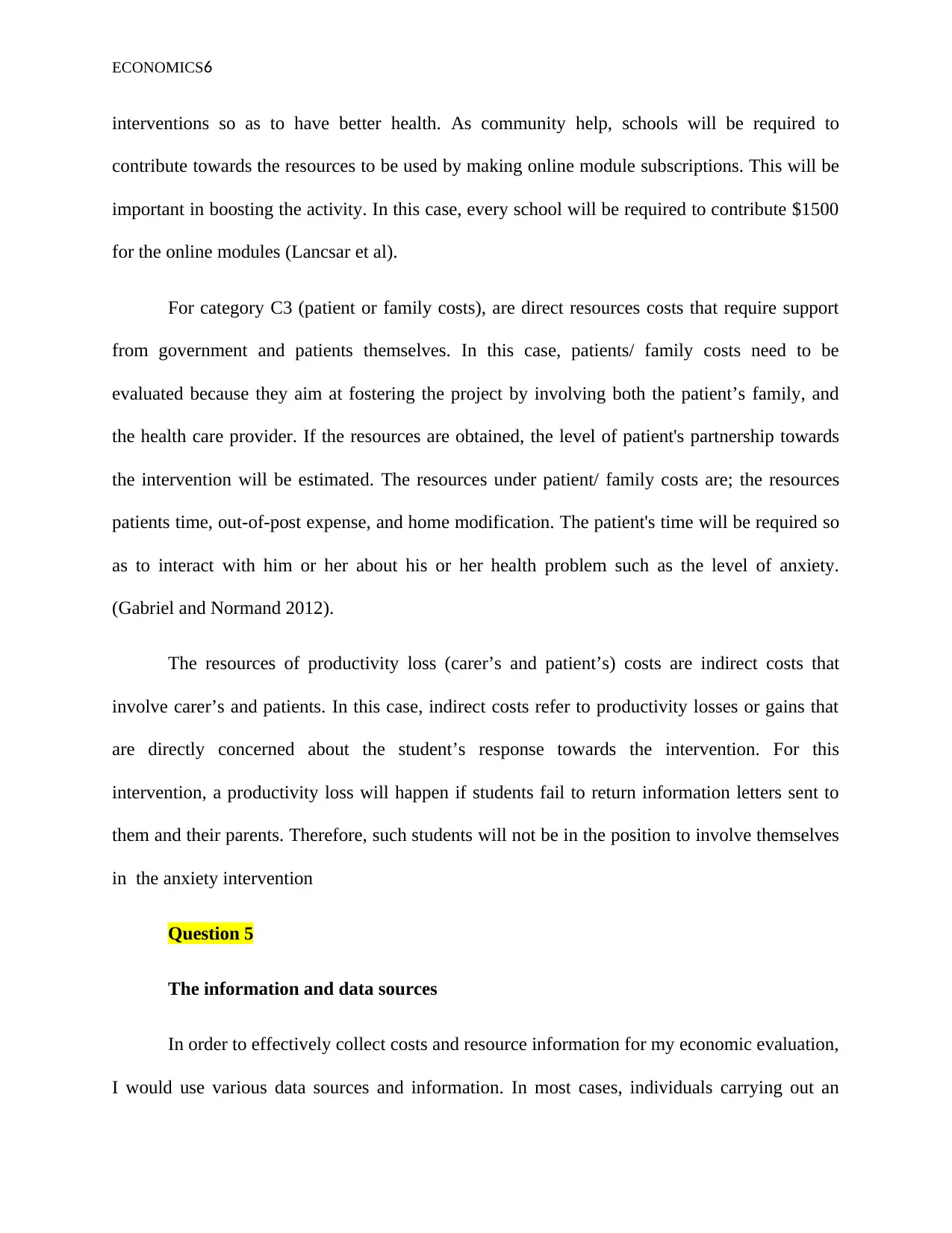
ECONOMICS6
interventions so as to have better health. As community help, schools will be required to
contribute towards the resources to be used by making online module subscriptions. This will be
important in boosting the activity. In this case, every school will be required to contribute $1500
for the online modules (Lancsar et al).
For category C3 (patient or family costs), are direct resources costs that require support
from government and patients themselves. In this case, patients/ family costs need to be
evaluated because they aim at fostering the project by involving both the patient’s family, and
the health care provider. If the resources are obtained, the level of patient's partnership towards
the intervention will be estimated. The resources under patient/ family costs are; the resources
patients time, out-of-post expense, and home modification. The patient's time will be required so
as to interact with him or her about his or her health problem such as the level of anxiety.
(Gabriel and Normand 2012).
The resources of productivity loss (carer’s and patient’s) costs are indirect costs that
involve carer’s and patients. In this case, indirect costs refer to productivity losses or gains that
are directly concerned about the student’s response towards the intervention. For this
intervention, a productivity loss will happen if students fail to return information letters sent to
them and their parents. Therefore, such students will not be in the position to involve themselves
in the anxiety intervention
Question 5
The information and data sources
In order to effectively collect costs and resource information for my economic evaluation,
I would use various data sources and information. In most cases, individuals carrying out an
interventions so as to have better health. As community help, schools will be required to
contribute towards the resources to be used by making online module subscriptions. This will be
important in boosting the activity. In this case, every school will be required to contribute $1500
for the online modules (Lancsar et al).
For category C3 (patient or family costs), are direct resources costs that require support
from government and patients themselves. In this case, patients/ family costs need to be
evaluated because they aim at fostering the project by involving both the patient’s family, and
the health care provider. If the resources are obtained, the level of patient's partnership towards
the intervention will be estimated. The resources under patient/ family costs are; the resources
patients time, out-of-post expense, and home modification. The patient's time will be required so
as to interact with him or her about his or her health problem such as the level of anxiety.
(Gabriel and Normand 2012).
The resources of productivity loss (carer’s and patient’s) costs are indirect costs that
involve carer’s and patients. In this case, indirect costs refer to productivity losses or gains that
are directly concerned about the student’s response towards the intervention. For this
intervention, a productivity loss will happen if students fail to return information letters sent to
them and their parents. Therefore, such students will not be in the position to involve themselves
in the anxiety intervention
Question 5
The information and data sources
In order to effectively collect costs and resource information for my economic evaluation,
I would use various data sources and information. In most cases, individuals carrying out an
⊘ This is a preview!⊘
Do you want full access?
Subscribe today to unlock all pages.

Trusted by 1+ million students worldwide
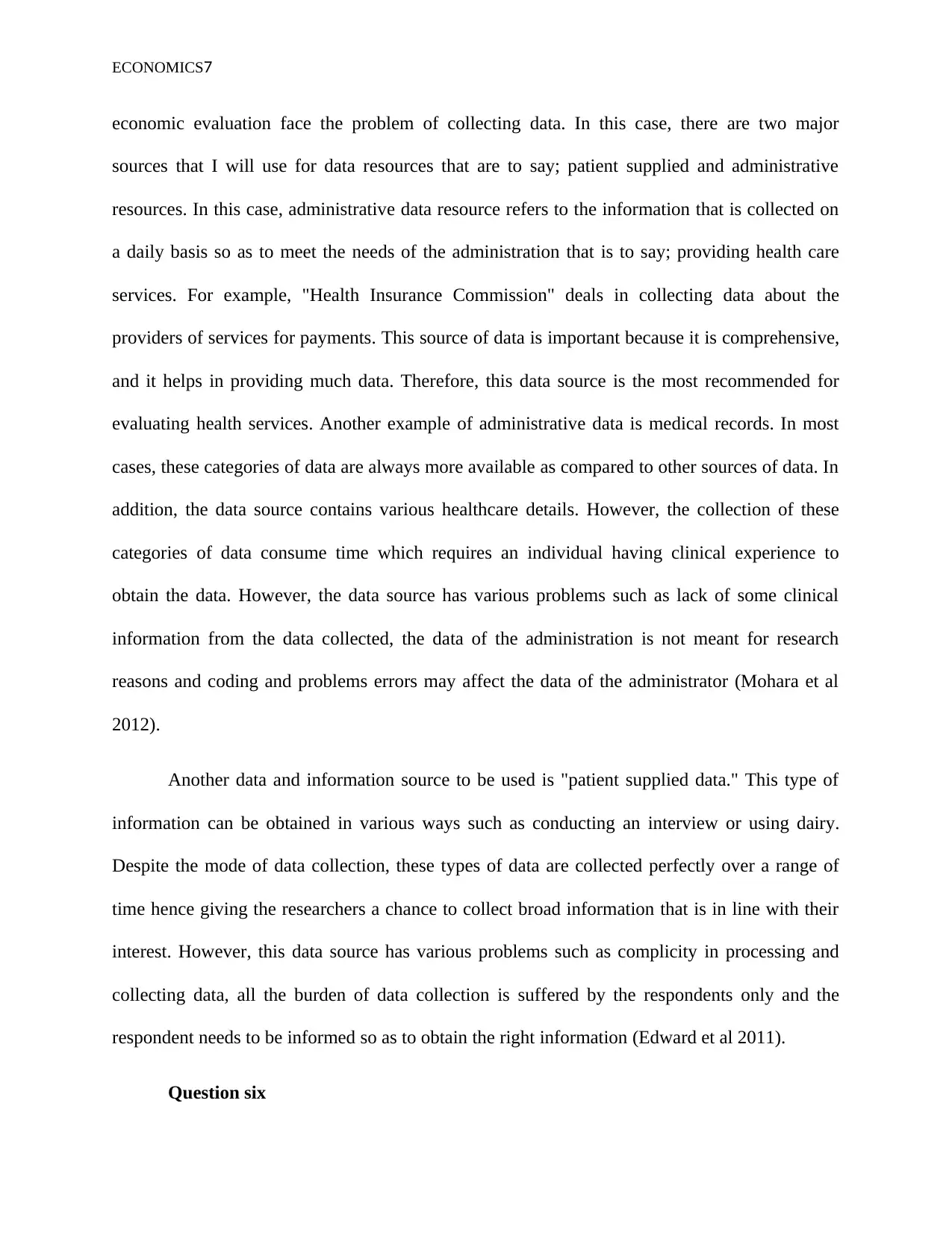
ECONOMICS7
economic evaluation face the problem of collecting data. In this case, there are two major
sources that I will use for data resources that are to say; patient supplied and administrative
resources. In this case, administrative data resource refers to the information that is collected on
a daily basis so as to meet the needs of the administration that is to say; providing health care
services. For example, "Health Insurance Commission" deals in collecting data about the
providers of services for payments. This source of data is important because it is comprehensive,
and it helps in providing much data. Therefore, this data source is the most recommended for
evaluating health services. Another example of administrative data is medical records. In most
cases, these categories of data are always more available as compared to other sources of data. In
addition, the data source contains various healthcare details. However, the collection of these
categories of data consume time which requires an individual having clinical experience to
obtain the data. However, the data source has various problems such as lack of some clinical
information from the data collected, the data of the administration is not meant for research
reasons and coding and problems errors may affect the data of the administrator (Mohara et al
2012).
Another data and information source to be used is "patient supplied data." This type of
information can be obtained in various ways such as conducting an interview or using dairy.
Despite the mode of data collection, these types of data are collected perfectly over a range of
time hence giving the researchers a chance to collect broad information that is in line with their
interest. However, this data source has various problems such as complicity in processing and
collecting data, all the burden of data collection is suffered by the respondents only and the
respondent needs to be informed so as to obtain the right information (Edward et al 2011).
Question six
economic evaluation face the problem of collecting data. In this case, there are two major
sources that I will use for data resources that are to say; patient supplied and administrative
resources. In this case, administrative data resource refers to the information that is collected on
a daily basis so as to meet the needs of the administration that is to say; providing health care
services. For example, "Health Insurance Commission" deals in collecting data about the
providers of services for payments. This source of data is important because it is comprehensive,
and it helps in providing much data. Therefore, this data source is the most recommended for
evaluating health services. Another example of administrative data is medical records. In most
cases, these categories of data are always more available as compared to other sources of data. In
addition, the data source contains various healthcare details. However, the collection of these
categories of data consume time which requires an individual having clinical experience to
obtain the data. However, the data source has various problems such as lack of some clinical
information from the data collected, the data of the administration is not meant for research
reasons and coding and problems errors may affect the data of the administrator (Mohara et al
2012).
Another data and information source to be used is "patient supplied data." This type of
information can be obtained in various ways such as conducting an interview or using dairy.
Despite the mode of data collection, these types of data are collected perfectly over a range of
time hence giving the researchers a chance to collect broad information that is in line with their
interest. However, this data source has various problems such as complicity in processing and
collecting data, all the burden of data collection is suffered by the respondents only and the
respondent needs to be informed so as to obtain the right information (Edward et al 2011).
Question six
Paraphrase This Document
Need a fresh take? Get an instant paraphrase of this document with our AI Paraphraser
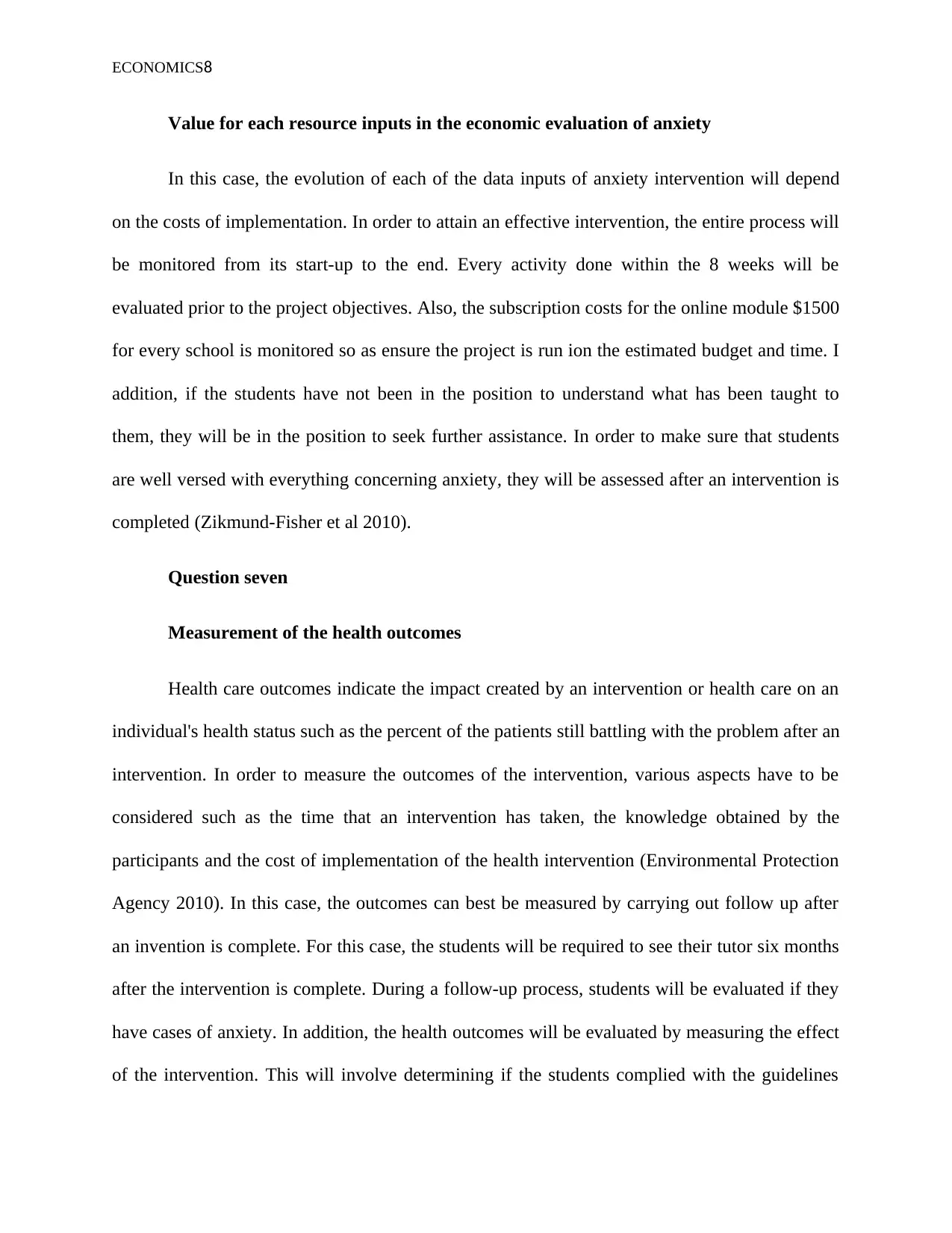
ECONOMICS8
Value for each resource inputs in the economic evaluation of anxiety
In this case, the evolution of each of the data inputs of anxiety intervention will depend
on the costs of implementation. In order to attain an effective intervention, the entire process will
be monitored from its start-up to the end. Every activity done within the 8 weeks will be
evaluated prior to the project objectives. Also, the subscription costs for the online module $1500
for every school is monitored so as ensure the project is run ion the estimated budget and time. I
addition, if the students have not been in the position to understand what has been taught to
them, they will be in the position to seek further assistance. In order to make sure that students
are well versed with everything concerning anxiety, they will be assessed after an intervention is
completed (Zikmund-Fisher et al 2010).
Question seven
Measurement of the health outcomes
Health care outcomes indicate the impact created by an intervention or health care on an
individual's health status such as the percent of the patients still battling with the problem after an
intervention. In order to measure the outcomes of the intervention, various aspects have to be
considered such as the time that an intervention has taken, the knowledge obtained by the
participants and the cost of implementation of the health intervention (Environmental Protection
Agency 2010). In this case, the outcomes can best be measured by carrying out follow up after
an invention is complete. For this case, the students will be required to see their tutor six months
after the intervention is complete. During a follow-up process, students will be evaluated if they
have cases of anxiety. In addition, the health outcomes will be evaluated by measuring the effect
of the intervention. This will involve determining if the students complied with the guidelines
Value for each resource inputs in the economic evaluation of anxiety
In this case, the evolution of each of the data inputs of anxiety intervention will depend
on the costs of implementation. In order to attain an effective intervention, the entire process will
be monitored from its start-up to the end. Every activity done within the 8 weeks will be
evaluated prior to the project objectives. Also, the subscription costs for the online module $1500
for every school is monitored so as ensure the project is run ion the estimated budget and time. I
addition, if the students have not been in the position to understand what has been taught to
them, they will be in the position to seek further assistance. In order to make sure that students
are well versed with everything concerning anxiety, they will be assessed after an intervention is
completed (Zikmund-Fisher et al 2010).
Question seven
Measurement of the health outcomes
Health care outcomes indicate the impact created by an intervention or health care on an
individual's health status such as the percent of the patients still battling with the problem after an
intervention. In order to measure the outcomes of the intervention, various aspects have to be
considered such as the time that an intervention has taken, the knowledge obtained by the
participants and the cost of implementation of the health intervention (Environmental Protection
Agency 2010). In this case, the outcomes can best be measured by carrying out follow up after
an invention is complete. For this case, the students will be required to see their tutor six months
after the intervention is complete. During a follow-up process, students will be evaluated if they
have cases of anxiety. In addition, the health outcomes will be evaluated by measuring the effect
of the intervention. This will involve determining if the students complied with the guidelines
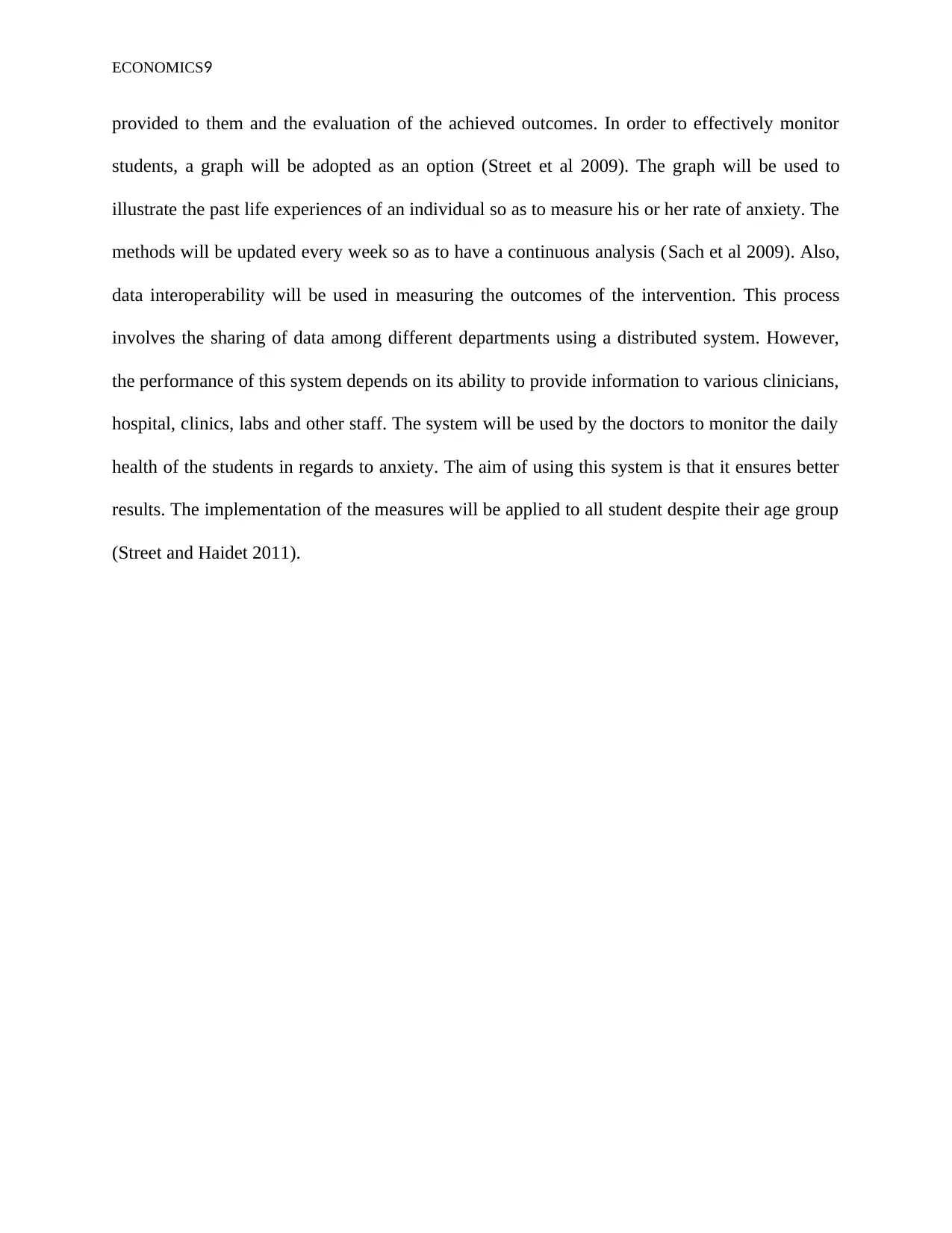
ECONOMICS9
provided to them and the evaluation of the achieved outcomes. In order to effectively monitor
students, a graph will be adopted as an option (Street et al 2009). The graph will be used to
illustrate the past life experiences of an individual so as to measure his or her rate of anxiety. The
methods will be updated every week so as to have a continuous analysis (Sach et al 2009). Also,
data interoperability will be used in measuring the outcomes of the intervention. This process
involves the sharing of data among different departments using a distributed system. However,
the performance of this system depends on its ability to provide information to various clinicians,
hospital, clinics, labs and other staff. The system will be used by the doctors to monitor the daily
health of the students in regards to anxiety. The aim of using this system is that it ensures better
results. The implementation of the measures will be applied to all student despite their age group
(Street and Haidet 2011).
provided to them and the evaluation of the achieved outcomes. In order to effectively monitor
students, a graph will be adopted as an option (Street et al 2009). The graph will be used to
illustrate the past life experiences of an individual so as to measure his or her rate of anxiety. The
methods will be updated every week so as to have a continuous analysis (Sach et al 2009). Also,
data interoperability will be used in measuring the outcomes of the intervention. This process
involves the sharing of data among different departments using a distributed system. However,
the performance of this system depends on its ability to provide information to various clinicians,
hospital, clinics, labs and other staff. The system will be used by the doctors to monitor the daily
health of the students in regards to anxiety. The aim of using this system is that it ensures better
results. The implementation of the measures will be applied to all student despite their age group
(Street and Haidet 2011).
⊘ This is a preview!⊘
Do you want full access?
Subscribe today to unlock all pages.

Trusted by 1+ million students worldwide
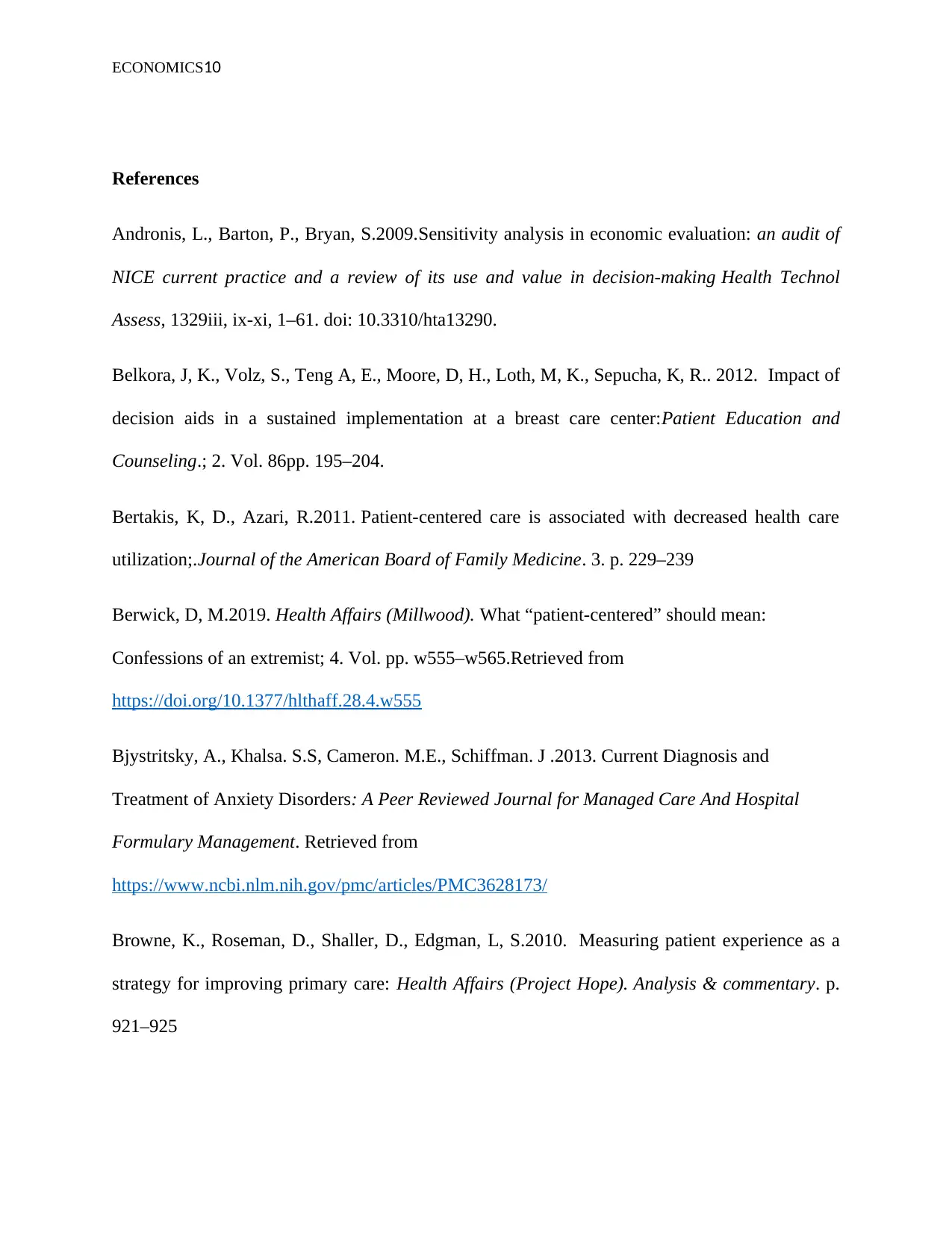
ECONOMICS10
References
Andronis, L., Barton, P., Bryan, S.2009.Sensitivity analysis in economic evaluation: an audit of
NICE current practice and a review of its use and value in decision-making Health Technol
Assess, 1329iii, ix-xi, 1–61. doi: 10.3310/hta13290.
Belkora, J, K., Volz, S., Teng A, E., Moore, D, H., Loth, M, K., Sepucha, K, R.. 2012. Impact of
decision aids in a sustained implementation at a breast care center:Patient Education and
Counseling.; 2. Vol. 86pp. 195–204.
Bertakis, K, D., Azari, R.2011. Patient-centered care is associated with decreased health care
utilization;.Journal of the American Board of Family Medicine. 3. p. 229–239
Berwick, D, M.2019. Health Affairs (Millwood). What “patient-centered” should mean:
Confessions of an extremist; 4. Vol. pp. w555–w565.Retrieved from
https://doi.org/10.1377/hlthaff.28.4.w555
Bjystritsky, A., Khalsa. S.S, Cameron. M.E., Schiffman. J .2013. Current Diagnosis and
Treatment of Anxiety Disorders: A Peer Reviewed Journal for Managed Care And Hospital
Formulary Management. Retrieved from
https://www.ncbi.nlm.nih.gov/pmc/articles/PMC3628173/
Browne, K., Roseman, D., Shaller, D., Edgman, L, S.2010. Measuring patient experience as a
strategy for improving primary care: Health Affairs (Project Hope). Analysis & commentary. p.
921–925
References
Andronis, L., Barton, P., Bryan, S.2009.Sensitivity analysis in economic evaluation: an audit of
NICE current practice and a review of its use and value in decision-making Health Technol
Assess, 1329iii, ix-xi, 1–61. doi: 10.3310/hta13290.
Belkora, J, K., Volz, S., Teng A, E., Moore, D, H., Loth, M, K., Sepucha, K, R.. 2012. Impact of
decision aids in a sustained implementation at a breast care center:Patient Education and
Counseling.; 2. Vol. 86pp. 195–204.
Bertakis, K, D., Azari, R.2011. Patient-centered care is associated with decreased health care
utilization;.Journal of the American Board of Family Medicine. 3. p. 229–239
Berwick, D, M.2019. Health Affairs (Millwood). What “patient-centered” should mean:
Confessions of an extremist; 4. Vol. pp. w555–w565.Retrieved from
https://doi.org/10.1377/hlthaff.28.4.w555
Bjystritsky, A., Khalsa. S.S, Cameron. M.E., Schiffman. J .2013. Current Diagnosis and
Treatment of Anxiety Disorders: A Peer Reviewed Journal for Managed Care And Hospital
Formulary Management. Retrieved from
https://www.ncbi.nlm.nih.gov/pmc/articles/PMC3628173/
Browne, K., Roseman, D., Shaller, D., Edgman, L, S.2010. Measuring patient experience as a
strategy for improving primary care: Health Affairs (Project Hope). Analysis & commentary. p.
921–925
Paraphrase This Document
Need a fresh take? Get an instant paraphrase of this document with our AI Paraphraser
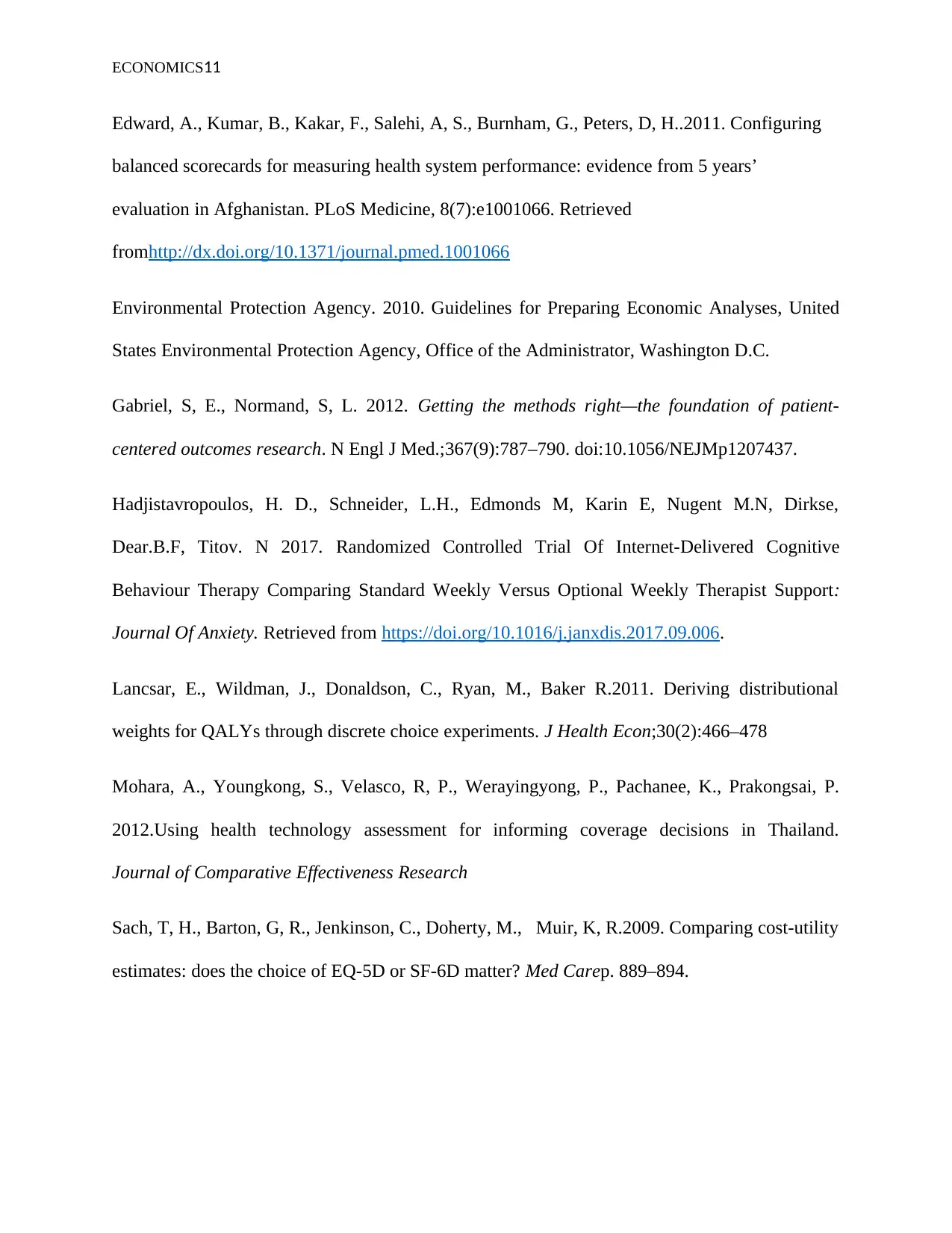
ECONOMICS11
Edward, A., Kumar, B., Kakar, F., Salehi, A, S., Burnham, G., Peters, D, H..2011. Configuring
balanced scorecards for measuring health system performance: evidence from 5 years’
evaluation in Afghanistan. PLoS Medicine, 8(7):e1001066. Retrieved
fromhttp://dx.doi.org/10.1371/journal.pmed.1001066
Environmental Protection Agency. 2010. Guidelines for Preparing Economic Analyses, United
States Environmental Protection Agency, Office of the Administrator, Washington D.C.
Gabriel, S, E., Normand, S, L. 2012. Getting the methods right—the foundation of patient-
centered outcomes research. N Engl J Med.;367(9):787–790. doi:10.1056/NEJMp1207437.
Hadjistavropoulos, H. D., Schneider, L.H., Edmonds M, Karin E, Nugent M.N, Dirkse,
Dear.B.F, Titov. N 2017. Randomized Controlled Trial Of Internet-Delivered Cognitive
Behaviour Therapy Comparing Standard Weekly Versus Optional Weekly Therapist Support:
Journal Of Anxiety. Retrieved from https://doi.org/10.1016/j.janxdis.2017.09.006.
Lancsar, E., Wildman, J., Donaldson, C., Ryan, M., Baker R.2011. Deriving distributional
weights for QALYs through discrete choice experiments. J Health Econ;30(2):466–478
Mohara, A., Youngkong, S., Velasco, R, P., Werayingyong, P., Pachanee, K., Prakongsai, P.
2012.Using health technology assessment for informing coverage decisions in Thailand.
Journal of Comparative Effectiveness Research
Sach, T, H., Barton, G, R., Jenkinson, C., Doherty, M., Muir, K, R.2009. Comparing cost-utility
estimates: does the choice of EQ-5D or SF-6D matter? Med Carep. 889–894.
Edward, A., Kumar, B., Kakar, F., Salehi, A, S., Burnham, G., Peters, D, H..2011. Configuring
balanced scorecards for measuring health system performance: evidence from 5 years’
evaluation in Afghanistan. PLoS Medicine, 8(7):e1001066. Retrieved
fromhttp://dx.doi.org/10.1371/journal.pmed.1001066
Environmental Protection Agency. 2010. Guidelines for Preparing Economic Analyses, United
States Environmental Protection Agency, Office of the Administrator, Washington D.C.
Gabriel, S, E., Normand, S, L. 2012. Getting the methods right—the foundation of patient-
centered outcomes research. N Engl J Med.;367(9):787–790. doi:10.1056/NEJMp1207437.
Hadjistavropoulos, H. D., Schneider, L.H., Edmonds M, Karin E, Nugent M.N, Dirkse,
Dear.B.F, Titov. N 2017. Randomized Controlled Trial Of Internet-Delivered Cognitive
Behaviour Therapy Comparing Standard Weekly Versus Optional Weekly Therapist Support:
Journal Of Anxiety. Retrieved from https://doi.org/10.1016/j.janxdis.2017.09.006.
Lancsar, E., Wildman, J., Donaldson, C., Ryan, M., Baker R.2011. Deriving distributional
weights for QALYs through discrete choice experiments. J Health Econ;30(2):466–478
Mohara, A., Youngkong, S., Velasco, R, P., Werayingyong, P., Pachanee, K., Prakongsai, P.
2012.Using health technology assessment for informing coverage decisions in Thailand.
Journal of Comparative Effectiveness Research
Sach, T, H., Barton, G, R., Jenkinson, C., Doherty, M., Muir, K, R.2009. Comparing cost-utility
estimates: does the choice of EQ-5D or SF-6D matter? Med Carep. 889–894.
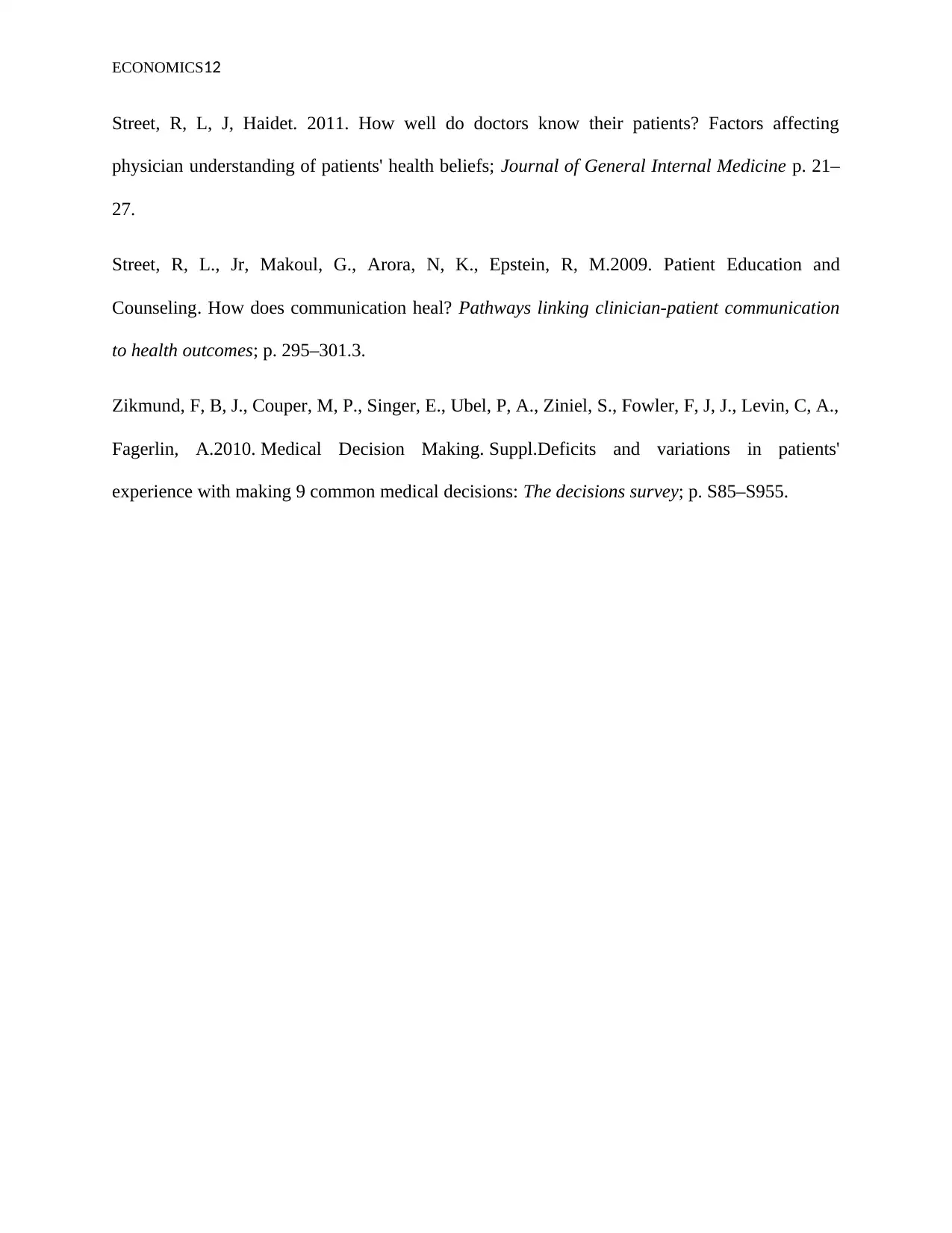
ECONOMICS12
Street, R, L, J, Haidet. 2011. How well do doctors know their patients? Factors affecting
physician understanding of patients' health beliefs; Journal of General Internal Medicine p. 21–
27.
Street, R, L., Jr, Makoul, G., Arora, N, K., Epstein, R, M.2009. Patient Education and
Counseling. How does communication heal? Pathways linking clinician-patient communication
to health outcomes; p. 295–301.3.
Zikmund, F, B, J., Couper, M, P., Singer, E., Ubel, P, A., Ziniel, S., Fowler, F, J, J., Levin, C, A.,
Fagerlin, A.2010. Medical Decision Making. Suppl.Deficits and variations in patients'
experience with making 9 common medical decisions: The decisions survey; p. S85–S955.
Street, R, L, J, Haidet. 2011. How well do doctors know their patients? Factors affecting
physician understanding of patients' health beliefs; Journal of General Internal Medicine p. 21–
27.
Street, R, L., Jr, Makoul, G., Arora, N, K., Epstein, R, M.2009. Patient Education and
Counseling. How does communication heal? Pathways linking clinician-patient communication
to health outcomes; p. 295–301.3.
Zikmund, F, B, J., Couper, M, P., Singer, E., Ubel, P, A., Ziniel, S., Fowler, F, J, J., Levin, C, A.,
Fagerlin, A.2010. Medical Decision Making. Suppl.Deficits and variations in patients'
experience with making 9 common medical decisions: The decisions survey; p. S85–S955.
⊘ This is a preview!⊘
Do you want full access?
Subscribe today to unlock all pages.

Trusted by 1+ million students worldwide
1 out of 12
Related Documents
Your All-in-One AI-Powered Toolkit for Academic Success.
+13062052269
info@desklib.com
Available 24*7 on WhatsApp / Email
![[object Object]](/_next/static/media/star-bottom.7253800d.svg)
Unlock your academic potential
Copyright © 2020–2025 A2Z Services. All Rights Reserved. Developed and managed by ZUCOL.





